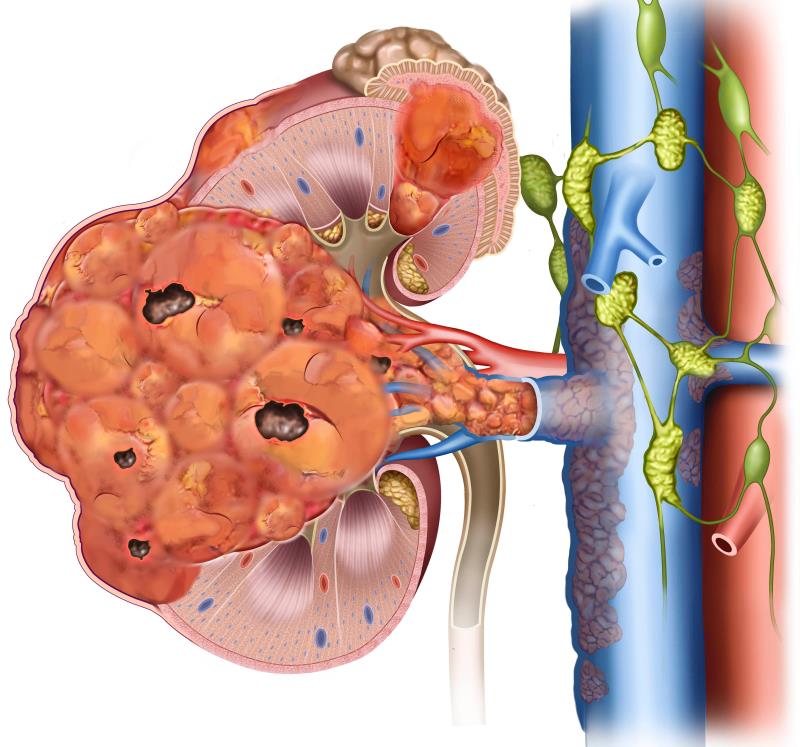Pembrolizumab + axitinib benefit sustained at 24 months for advanced RCC





The combination therapy of pembrolizumab + axitinib continued to demonstrate significant improvements in overall survival (OS) and progression-free survival (PFS) among patients with advanced renal cell carcinoma (RCC) over an extended 24-month follow-up, according to the KEYNOTE-426* study presented at ASCO20 Virtual Scientific Program.
This updated analysis included 861 patients with untreated advanced RCC who were randomized to receive either intravenous pembrolizumab 200 mg thrice/day for up to 35 cycles + oral axitinib 5 mg twice/day (n=432; aged 62 years, 71.3 percent male) or oral sunitinib 50 mg once/day for the first 4 weeks of each 6-week cycle (n=429; aged 61 years, 74.6 percent male). All patients were stratified by IMDC risk group (favourable, intermediate, or poor) and geographical region (North America, Western Europe, and rest of world) and were assessed at an extended follow-up of 24 months. [ASCO 2020, abstract 5001]
In the ITT population, patients treated with pembrolizumab + axitinib had a consistently significantly higher rate of OS (74.0 percent vs 66.0 percent; hazard ratio [HR], 0.68; p<0.001) and PFS at 24 months (38.0 percent vs 27.0 percent; HR, 0.71; p<0.0001) compared with sunitinib alone.
The objective response rate (ORR) also remained significantly higher in the pembrolizumab + axitinib arm vs the sunitinib alone arm (60.2 percent vs 39.9 percent; HR, 0.71; p<0.0001), with a complete response rate of 8.8 percent vs 3.0 percent, respectively.
In a subgroup analysis of patients with favourable risk, an improved PFS months (45.0 percent vs 35 percent; HR, 079) and ORR (69.6 percent vs 50.4 percent) was observed in the pembrolizumab + axitinib arm vs the sunitinib alone arm at 24 months.
The 24-month OS rate did not differ between the pembrolizumab + axitinib and the sunitinib alone arms in the favourable risk population (85.0 percent vs 88.0 percent). “There are several reasons for this, perhaps patients with favourable risk don’t benefit from the addition of immunotherapy … [or] another potential explanation is that patients with favourable risk have just that, favourable risk disease, and a known excellent OS,” said lead investigator Dr Elizabeth Plimack from Fox Chase Center in Philadelphia, Pennsylvania, US.
Superior OS, PFS, and ORR with pembrolizumab + axitinib was maintained in intermediate/poor-risk patients compared with sunitinib alone at 24 months (69.0 percent vs 56.0 percent; HR, 0.63 for OS, 34.0 percent vs 23.0 percent; HR, 0.69 for PFS, and 55.8 percent vs 35.2 percent for ORR).
However, the incidence of grade 3–5 treatment-related adverse events was slightly higher with pembrolizumab + axitinib vs sunitinib alone (66.9 percent vs 62.4 percent). Four and six deaths were reported due to toxicity in the pembrolizumab + axitinib and the sunitinib alone arms, respectively.
Nonetheless, more pembrolizumab + axitinib recipients experienced a target lesion reduction from baseline than sunitinib recipients (94.0 percent vs 86.0 percent).
In a post hoc landmark analysis of 745 patients who were alive at 6 months, the researchers found that a greater depth of tumour shrinkage was associated with increased OS in the pembrolizumab + axitinib arm vs the sunitinib alone arm.
“With [this] extended follow-up, pembrolizumab + axitinib continued to demonstrate clinically significant improved efficacy compared with sunitinib [alone] for patients with previously untreated advanced RCC,” Plimack said.
“[The overall] results continue to support pembrolizumab + axitinib as a standard of care [in this population],” she added.
*KEYNOTE-426: A phase III randomized, open-label study to evaluate efficacy and safety of pembrolizumab (MK-3475) in combination with axitinib versus sunitinib monotherapy as a first-line treatment for locally advanced or metastatic renal cell carcinoma (mRCC)